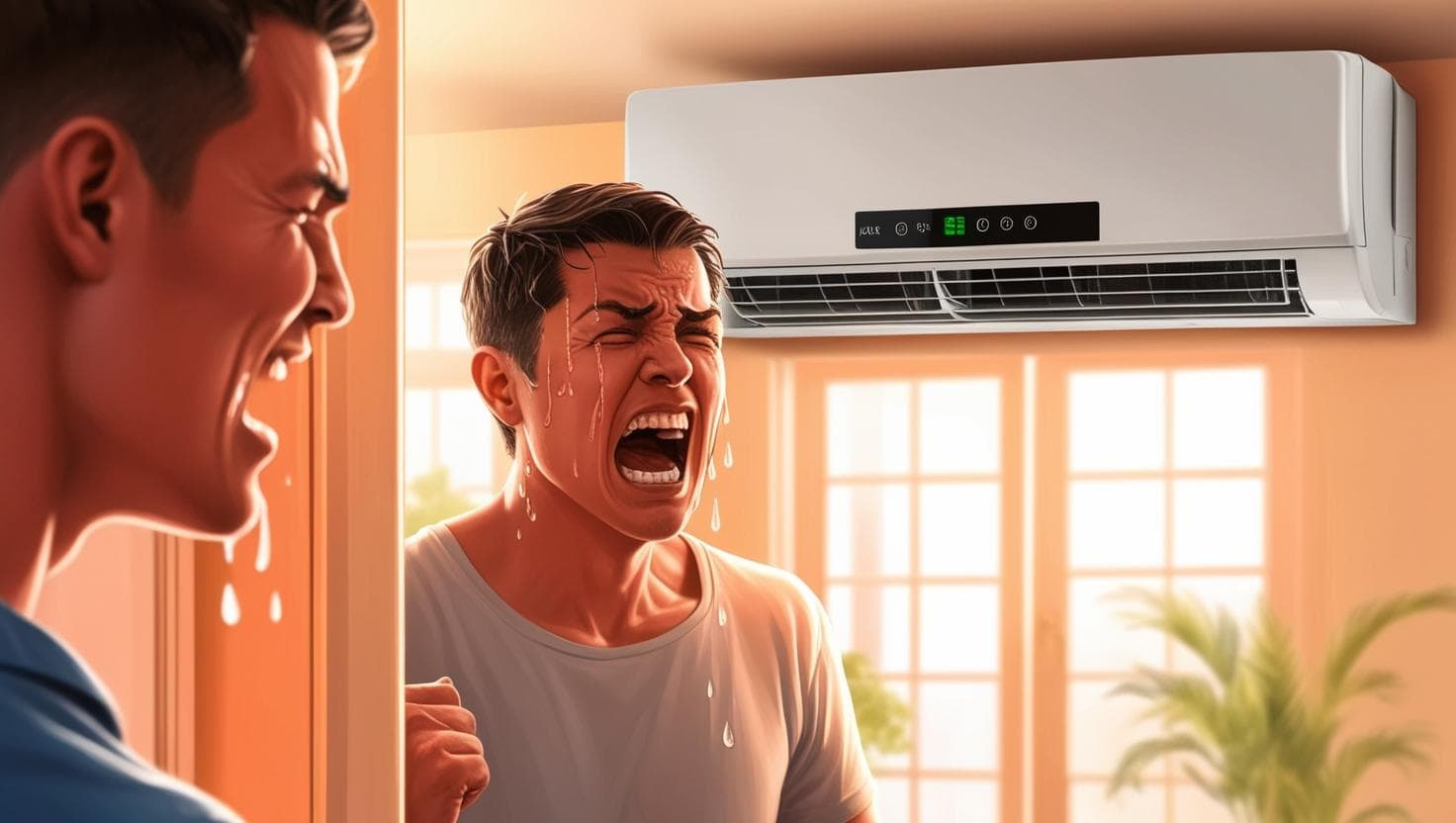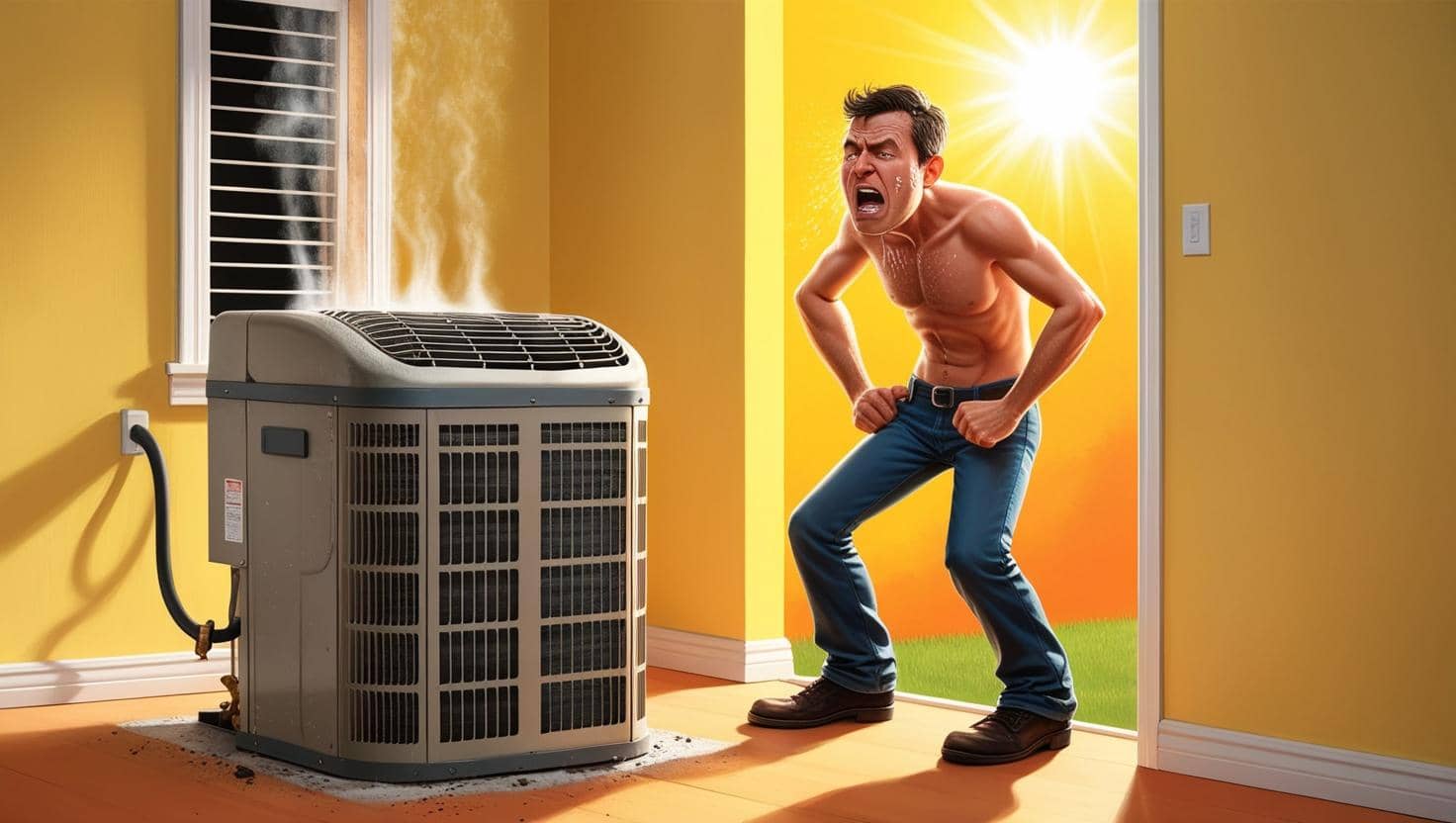Introduction
When your air conditioner stops blowing cold air, it can turn a comfortable home into a sweltering nightmare, especially during a scorching summer.
This common issue frustrates homeowners, but the good news is that many causes have straightforward solutions.
In this article, we’ll explore why your air conditioner might not be cooling properly, offer practical fixes you can try, and guide you on when to call a professional.
Whether it’s a simple maintenance task or a more complex issue, understanding the problem is the first step to restoring your cool, comfortable space.
Why Is My Air Conditioner Not Blowing Cold Air?

An air conditioner that’s running but not cooling can stem from various issues, ranging from minor oversights to mechanical failures. According to the U.S. Department of Energy, regular maintenance can prevent up to 80% of air conditioning problems, yet many homeowners overlook these tasks. Let’s dive into the most common reasons your air conditioner isn’t blowing cold air and how to address them.
1. Dirty Air Filters
One of the simplest yet most common culprits is a clogged air filter. Air filters trap dust, dirt, and debris to keep your AC unit running efficiently and your indoor air clean. Over time, these filters become blocked, restricting airflow and reducing the system’s ability to cool.
- Why it happens: A dirty filter forces the AC to work harder, which can cause the evaporator coils to freeze or the system to overheat.
- Solution: Check your air filter monthly and replace or clean it every 1-3 months, depending on usage and manufacturer recommendations. Most homes use disposable fiberglass or pleated filters, which cost $5-$20 and are easy to swap out.
- Example: Jane, a homeowner in Florida, noticed her AC wasn’t cooling her living room. After replacing a filter caked with dust, her unit was back to blowing cold air within hours.
2. Low Refrigerant Levels
Refrigerant is the lifeblood of your air conditioner, absorbing heat from your home and releasing it outside. If your AC isn’t blowing cold air, low refrigerant levels could be to blame.
- Why it happens: Leaks in the refrigerant lines or improper installation can cause refrigerant to escape. According to the Environmental Protection Agency (EPA), even a 10% loss of refrigerant can reduce an AC’s efficiency by 20%.
- Solution: Low refrigerant isn’t a DIY fix. Contact a licensed HVAC technician to locate and repair any leaks, then recharge the system with the correct amount of refrigerant. This typically costs $100-$500, depending on the severity of the leak.
- Tip: Regular maintenance can catch small leaks early, saving you from costly repairs.
3. Frozen Evaporator Coils
If your air conditioner is blowing warm or weak air, frozen evaporator coils might be the issue. These coils absorb heat from indoor air, but they can freeze over if airflow is restricted or refrigerant levels are low.
- Why it happens: Dirty filters, blocked vents, or low refrigerant can cause the coils to get too cold, leading to ice buildup. This prevents the coils from absorbing heat effectively.
- Solution:
- Turn off the AC to let the coils thaw (this can take 24-48 hours).
- Check and replace the air filter if it’s dirty.
- Ensure vents and registers are open and unobstructed.
- Call a professional if the problem persists, as it could indicate a refrigerant issue or a malfunctioning fan.
- Fun fact: Frozen coils can sometimes cause water leaks, as melting ice overwhelms the drain pan. Keep an eye out for puddles near your unit!
4. Thermostat Issues
Sometimes, the problem isn’t with the air conditioner itself but with the thermostat controlling it. A misconfigured or malfunctioning thermostat can prevent your AC from blowing cold air.
- Why it happens: Incorrect settings, dead batteries, or a faulty thermostat can send the wrong signals to your AC unit. For example, setting the thermostat to “fan only” mode will circulate air without cooling it.
- Solution:
- Check the thermostat settings to ensure it’s set to “cool” and the temperature is lower than the room’s current temperature.
- Replace batteries if it’s a battery-powered model.
- Calibrate or replace the thermostat if it’s outdated or malfunctioning. Modern smart thermostats, like those from Nest or Ecobee, can improve efficiency and cost $100-$250.
- Real-world example: Tom in Texas thought his AC was broken, but his thermostat was accidentally set to “heat.” A quick adjustment saved him a service call.
5. Blocked or Dirty Condenser Coils
The outdoor condenser unit releases heat from your home. If its coils are covered in dirt, leaves, or debris, it can’t expel heat efficiently, causing your air conditioner to blow warm air.
- Why it happens: Outdoor units are exposed to the elements, and debris like grass clippings or pollen can accumulate over time.
- Solution:
- Turn off the power to the outdoor unit.
- Gently clean the coils with a garden hose (avoid high-pressure settings to prevent damage).
- Trim nearby vegetation to ensure at least 2 feet of clearance around the unit.
- Schedule annual professional maintenance to keep the coils in top shape.
- Stat: The Air Conditioning Contractors of America (ACCA) notes that clean condenser coils can improve AC efficiency by up to 30%.
6. Electrical Problems
Electrical issues, such as tripped breakers, blown fuses, or faulty wiring, can disrupt your air conditioner’s ability to cool.
- Why it happens: Power surges, wear and tear, or pest damage (like rodents chewing wires) can cause electrical failures.
- Solution:
- Check your circuit breaker to see if the AC’s breaker has tripped. Reset it if needed.
- Inspect the outdoor unit for signs of damage, like burnt wires or pest activity.
- Call an electrician or HVAC technician for complex electrical repairs, which may cost $150-$400.
- Safety note: Always turn off power to the unit before inspecting electrical components to avoid shock.
7. Leaking or Blocked Ducts
If your home uses a central air system, leaky or blocked ducts can prevent cold air from reaching certain rooms, making it seem like your air conditioner isn’t blowing cold air.
- Why it happens: Ducts can develop leaks over time, or furniture and rugs can block vents, reducing airflow. The Department of Energy estimates that 20-30% of air in duct systems is lost due to leaks or poor insulation.
- Solution:
- Check for blocked vents and move furniture or objects that might be obstructing airflow.
- Seal visible duct leaks with mastic sealant or metal tape (not duct tape, despite the name!).
- Hire a professional to inspect and repair ductwork, which can cost $300-$1,000 depending on the extent of the damage.
- Pro tip: Insulating ducts in unconditioned spaces like attics can boost efficiency and keep your home cooler.
8. Undersized or Aging AC Unit
If your air conditioner is too small for your space or nearing the end of its lifespan, it may struggle to blow cold air.
- Why it happens: An undersized unit can’t handle the cooling load of a large home, while older units (10-15 years) lose efficiency over time. The average lifespan of an AC unit is 12-15 years, according to Energy Star.
- Solution:
- Have an HVAC professional assess whether your unit is appropriately sized for your home.
- Consider upgrading to a new, energy-efficient model if your unit is old or undersized. New units can save 20-40% on energy bills.
- Example: Sarah’s 15-year-old AC couldn’t keep up with her growing family’s needs. Replacing it with a properly sized unit restored cool comfort to her home.
Preventive Maintenance to Avoid Future Issues

Preventing your air conditioner from blowing warm air starts with regular maintenance. Here are some tips to keep your system running smoothly:
- Schedule annual tune-ups: A professional inspection can catch issues like low refrigerant or dirty coils before they escalate. Expect to pay $75-$200 for a tune-up.
- Clean regularly: Dust and vacuum around the indoor and outdoor units to prevent debris buildup.
- Monitor performance: Pay attention to unusual noises, weak airflow, or rising energy bills, as these can signal problems.
- Upgrade when needed: If your unit is over a decade old, consider investing in a modern, energy-efficient model to save on repairs and utility costs.
When to Call a Professional
While some fixes, like replacing air filters or clearing debris, are DIY-friendly, others require professional expertise. Call an HVAC technician if you encounter:
- Persistent warm air despite troubleshooting.
- Signs of refrigerant leaks (hissing sounds, oily residue near the unit).
- Electrical issues or frequent breaker trips.
- Frozen coils that don’t resolve after thawing.
A licensed technician can diagnose complex issues and ensure repairs comply with safety and environmental regulations. For example, handling refrigerants requires EPA certification due to their environmental impact.
The Cost of Ignoring the Problem
Ignoring an air conditioner that’s not blowing cold air can lead to bigger problems. A struggling unit consumes more energy, spiking your utility bills. The Department of Energy reports that poorly maintained ACs can increase energy costs by 15-20%. Worse, neglected issues like low refrigerant or frozen coils can cause compressor failure, a repair that can cost $1,000-$2,500 or require a full system replacement.
Real-Life Success Story
Consider Mike, a homeowner in Arizona, who noticed his AC was blowing warm air during a heatwave. Initially, he assumed it was a major issue, but after checking his air filter, he found it completely clogged with pet hair. Replacing the filter cost him $10 and 10 minutes, and his home was cool again by evening. Had he ignored the issue, his unit might have overheated, leading to a costly repair.
Conclusion
An air conditioner not blowing cold air is a common issue with a range of causes, from simple fixes like changing a filter to complex problems like refrigerant leaks.
By understanding the reasons behind the problem—dirty filters, low refrigerant, frozen coils, thermostat issues, and more—you can take action to restore your AC’s performance.
Regular maintenance, prompt troubleshooting, and knowing when to call a professional can keep your home cool and your energy bills in check. Don’t let a warm house ruin your summer—tackle the problem head-on and enjoy a comfortable, refreshing indoor environment.






More Stories
35 Witchy Halloween Decor Ideas for a Spooky and Stylish Home Transformation
30 Yellow Living Room 2025 Ideas That Will Brighten Your Home with Warmth, Color, and Style
Transform Your Outdoor Space with Decoradyard: Ideas, Tips, and Inspiration